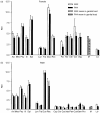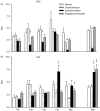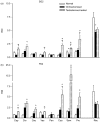Circulating immunoglobulin A- and immunoglobulin G-secreting hybridoma cells in peripheral blood preferably migrate to female genital tracts. The role of sex hormones
- PMID: 12100722
- PMCID: PMC1782727
- DOI: 10.1046/j.1365-2567.2002.01433.x
Circulating immunoglobulin A- and immunoglobulin G-secreting hybridoma cells in peripheral blood preferably migrate to female genital tracts. The role of sex hormones
Abstract
Antigen-specific circulating immunoglobulin-secreting cells (ISC) migrate to various secondary and tertiary lymphoid tissues. To understand the migration of the cells into the genital tract and its regulation by sex hormones, spleen-derived SG2 hybridoma cells secreting immunoglobulin G2b (IgG2b) and Peyer's patch-derived PA4 hybridoma cells secreting polymer IgA were labelled with 3H-TdR, and intravenously injected into syngeneic mice of both sexes. Using flow cytometry, surface molecular markers of plasma cells, CD38 and CD138, and adhesion molecules, CD49d, CD162, and CD11a were found to be positive in SG2 and PA4 cells, but CD62L, alpha4beta7 and CD44 were not expressed on these cells. The relative distribution indexes (RDIs) of the cells in genital tract and other tissues were measured. The means of RDIs of SG2 and PA4 cells in female genital tissues were 6.5 and 4.5 times as many as the means in male genital tissues, respectively. The treatment of ovariectomized mice with beta-oestradiol significantly increased the RDIs of PA4 cells in cervix and vagina, but decreased the RDIs of SG2 cells in vagina, horn of uterus, uterus and rectum (P<0.05). Progesterone treatment increased the RDIs of PA4 cells in vagina and rectum (P<0.05). The treatment with testosterone significantly increased the RDIs of SG2 and PA4 cells in epididymis and accessory sex glands (P<0.05). These results demonstrate that the female genital tract is the preferable site for the migration of circulating hybridoma cells to the male genital tract, and sex hormones play an important role in regulation of the migration of circulating ISC to genital tracts.
Figures







Similar articles
-
Migration of mouse antibody-secreting hybridoma cells from blood to genital tract and its regulation by sex hormones are associated with the differential expression patterns of adhesion molecules and chemokines in the tract rather than in the antibody-secreting cells.J Reprod Immunol. 2007 Jun;74(1-2):78-89. doi: 10.1016/j.jri.2006.09.003. Epub 2006 Dec 5. J Reprod Immunol. 2007. PMID: 17150254
-
Transport of anti-sperm monoclonal IgA and IgG into murine male and female genital tracts from blood. Effect of sex hormones.J Immunol. 1996 Feb 1;156(3):1014-9. J Immunol. 1996. PMID: 8557974
-
Effects of ovarian steroids on immunoglobulin-secreting cell function in healthy women.Clin Diagn Lab Immunol. 2003 Sep;10(5):944-9. doi: 10.1128/cdli.10.5.944-949.2003. Clin Diagn Lab Immunol. 2003. PMID: 12965931 Free PMC article.
-
Mucosal immunity in the female genital tract: relevance to vaccination efforts against the human immunodeficiency virus.AIDS Res Hum Retroviruses. 1994;10 Suppl 2:S11-20. AIDS Res Hum Retroviruses. 1994. PMID: 7865284 Review.
-
Immunization for protection of the reproductive tract: a review.Am J Reprod Immunol. 2002 May;47(5):265-8. doi: 10.1034/j.1600-0897.2002.01099.x. Am J Reprod Immunol. 2002. PMID: 12148540 Review.
References
-
- Cohen MS, Anderson DJ. Sexually Transmitted Diseases. 4. New York: McGraw-Hill Companies, Inc.; 1999. Genitourinary mucosal defenses; pp. 173–90.
-
- Mestecky J, Fultz PN. Mucosal immune system of human genital tract. J Infect Dis. 1999;179(Suppl. 3):S470–4. - PubMed
-
- Frayne J, Hall L. The potential use of sperm antigens as targets for immunocontraception: past, present and future. J Reprod Immunol. 1999;43:1–33. - PubMed
-
- Ogra PL, Mestecky J, Lamm ME, Strober W, Bienenstock J, McGhee JR, editors. Mucosal Immunology. San Diego: Academic Press; 1999.
-
- Mostad SB, Kreiss JK. Shedding of HIV-1 in genital tract. AIDS. 1996;10:1305–12. - PubMed
Publication types
MeSH terms
Substances
LinkOut - more resources
Full Text Sources
Research Materials
Miscellaneous

